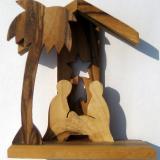Many of us that are familiar with the story of Jesus’ birth have a rosy, Christmas-tinted view of Bethlehem. We envision Mary on the donkey, the full inn, and the idyllic stable with just a handful of clean and sweet-smelling animals. Clean straw covers the floor. Nativities depicting this scene can be purchased at www.holyland-gifts.com, for example.
But what is Bethlehem like today? Would the little town of Bethlehem still be recognizable to Mary and Joseph? Can we still see a little bit of what it was like at the time of Jesus’ birth?
Bethlehem today is a small city of about 22,000 people. It is controlled by the Palestinian Authority rather than Israel and has a mixed religious population. Two suburbs and settlements controlled by the Israelis surround the city.
As might be suspected, shopping is a bustling tourist industry in modern day Bethlehem, especially at Christmastime. Shops line the streets, and the proprietors can be found selling a multitude of items native to the area, such as jewelry and spices. Olive wood carvings, such as those found at www.holyland-gifts.com, are the best selling items among pilgrims visiting Bethlehem.
At one point in the mid-twentieth century, when the British first left Palestine, Christians made up a huge majority of the population of Bethlehem, but they have been a shrinking minority for the last 20 years. As evidence of the Christian heritage of the city, there are several churches throughout the city commemorating the birth of Christ, most famously the Nativity Church. This is the oldest remaining church in the Holy Land and was built by Constantine and him mother, Helena. It is rather plain on the outside but quite beautiful on the inside. Ancient mosaics can be found covered by the current floor.
Ancient tradition points to a cave as the place of Jesus’ birth, since animals were often housed in caves for shelter and safety. The Byzantine church was erected around the cave that was believed to be the site of the nativity, and a star marks the area on the floor that traditionally is the exact spot where Mary gave birth to the baby Jesus.
Even today shepherds can be found “watching their flocks by night” outside of the city. Shepherds still wear the traditional garb and can give us a peek into what it may have looked like on that holy night when the angels appeared to the shepherds.

